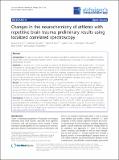| dc.contributor.author | Lin, Alexander P | en_US |
| dc.contributor.author | Ramadan, Saadallah | en_US |
| dc.contributor.author | Stern, Robert A | en_US |
| dc.contributor.author | Box, Hayden C | en_US |
| dc.contributor.author | Nowinski, Christopher J | en_US |
| dc.contributor.author | Ross, Brian D | en_US |
| dc.contributor.author | Mountford, Carolyn E | en_US |
| dc.date.accessioned | 2015-04-01T15:30:18Z | |
| dc.date.issued | 2015 | en_US |
| dc.identifier.citation | Lin, Alexander P, Saadallah Ramadan, Robert A Stern, Hayden C Box, Christopher J Nowinski, Brian D Ross, and Carolyn E Mountford. 2015. “Changes in the neurochemistry of athletes with repetitive brain trauma: preliminary results using localized correlated spectroscopy.” Alzheimer's Research & Therapy 7 (1): 13. doi:10.1186/s13195-015-0094-5. http://dx.doi.org/10.1186/s13195-015-0094-5. | en |
| dc.identifier.issn | 1758-9193 | en |
| dc.identifier.uri | http://nrs.harvard.edu/urn-3:HUL.InstRepos:14351267 | |
| dc.description.abstract | Introduction: The goal was to identify which neurochemicals differ in professional athletes with repetitive brain trauma (RBT) when compared to healthy controls using a relatively new technology, in vivo Localized COrrelated SpectroscopY (L-COSY). Methods: To achieve this, L-COSY was used to examine five former professional male athletes with 11 to 28 years of exposure to contact sports. Each athlete who had had multiple symptomatic concussions and repetitive sub concussive trauma during their career was assessed by an experienced neuropsychologist. All athletes had clinical symptoms including headaches, memory loss, confusion, impaired judgment, impulse control problems, aggression, and depression. Five healthy men, age and weight matched to the athlete cohort and with no history of brain trauma, were recruited as controls. Data were collected from the posterior cingulate gyrus using a 3 T clinical magnetic resonance scanner equipped with a 32 channel head coil. Results: The variation of the method was calculated by repeated examination of a healthy control and phantom and found to be 10% and 5%, respectively, or less. The L-COSY measured large and statistically significant differences (P ≤0.05), between healthy controls and those athletes with RBT. Men with RBT showed higher levels of glutamine/glutamate (31%), choline (65%), fucosylated molecules (60%) and phenylalanine (46%). The results were evaluated and the sample size of five found to achieve a significance level P = 0.05 and a power of 90%. Differences in N-acetyl aspartate and myo-inositol between RBT and controls were small and were not statistically significance. Conclusions: A study of a small cohort of professional athletes, with a history of RBT and symptoms of chronic traumatic encephalopathy when compared with healthy controls using 2D L-COSY, showed elevations in brain glutamate/glutamine and choline as recorded previously for early traumatic brain injury. For the first time increases in phenylalanine and fucose are recorded in the brains of athletes with RBT. Larger studies utilizing the L-COSY method may offer an in-life method of diagnosis and personalized approach for monitoring the acute effects of mild traumatic brain injury and the chronic effects of RBT. | en |
| dc.language.iso | en_US | en |
| dc.publisher | BioMed Central | en |
| dc.relation.isversionof | doi:10.1186/s13195-015-0094-5 | en |
| dc.relation.hasversion | http://www.ncbi.nlm.nih.gov/pmc/articles/PMC4361214/pdf/ | en |
| dash.license | LAA | en_US |
| dc.title | Changes in the neurochemistry of athletes with repetitive brain trauma: preliminary results using localized correlated spectroscopy | en |
| dc.type | Journal Article | en_US |
| dc.description.version | Version of Record | en |
| dc.relation.journal | Alzheimer's Research & Therapy | en |
| dash.depositing.author | Lin, Alexander P | en_US |
| dc.date.available | 2015-04-01T15:30:18Z | |
| dc.identifier.doi | 10.1186/s13195-015-0094-5 | * |
| dash.contributor.affiliated | Ross, Brian D | |
| dash.contributor.affiliated | Lin, Alexander | |


